There’s no denying that the best running shoes can help you conquer a variety of workout environments, from the treadmill to the track, city streets, race day courses, and more. However, there’s one area where these road-centric sneakers can begin to falter — the trails. To help you maintain traction and comfort while traversing through winding hills, root-riddled turns, muddy bogs, and other obstacles, the best trail running shoes can be perfect additions to your running shoe rotation.
Purchasing trail running shoes can be a lot like searching for all-terrain tires for your vehicle, meaning you want a good sense of tread and protection without sacrificing ride comfort and overall weight. To help you take your training into the wild outdoors, we’ve run in dozens of popular silhouettes and consulted with our team of experts to curate this list of our favorite trail running shoes available today.
The 14 Best Trail Running Shoes of 2025
- Best Trail Running Shoes Overall: HOKA Speedgoat 5
- Best Road-to-Trail Trail Running Shoes: Nike Pegasus Trail 4 GORE-TEX
- Best Budget Trail Running Shoes: Merrell Morphlite
- Best Cushioned Trail Running Shoes: Brooks Caldera 7
- Best Trail Running Shoes for Daily Training: Saucony Peregrine 14
- Best Trail Running Shoes for Speedwork: HOKA Tecton X 2
- Best Trail Running Shoes for Muddy Conditions: Inov-8 Mudtalon
- Best Stability Trail Running Shoes: Brooks Cascadia 17
- Best Trail Running Shoes for Long Distances: Topo Athletic Ultraventure 3
- Best Trail Running Shoes for Winter Conditions: Icebug NewRun BUGrip GTX
- Best Trail Running Shoes for Rocky Conditions: La Sportiva Bushido III
- Most Durable Trail Running Shoes: Norda 002
- Best Trail Running Shoes for Wide Feet: Altra Lone Peak 8
- Best Customizable Trail Running Shoes: Speedland GS:PGH
How We Tested and Chose the Best Trail Running Shoes
The BarBend team is made up of competitive athletes, certified personal trainers, and lifelong fitness enthusiasts. To make our list of the best trail shoes, we got hands-on with 30 different shoe profiles from top brands, using a multi-point methodology to rate each profile on a scale of 1 (lowest) to 5 (highest) to determine our top picks. Below are some of the categories and components we looked at to make our list.
For further information on how we trial and test the products chosen for this guide and more, be sure to read the BarBend Equipment Testing Methodology page.
- Traction: Naturally, trail running shoes should feature a more aggressive outsole that can retain grip over uneven and loose terrain. We ran these tested sneakers through multiple trail conditions, including mud, rain, and packed trailways, to determine how grippy each silhouette was and where traction could potentially be compromised.
- Durability: With debris like sticks and gravel aplenty along the trail, as well as the potential for scrapes and scuffs when traversing different obstacles, it’s imperative to look for a trail shoe that can withstand the rigors of the discipline. We examined how resilient each profile was through multiple wears, highlighting any potential weak points that could be an issue when taking these kicks out for a run.
- Breathability: Given that the uppers of trail shoes need to be durable enough for the training conditions, breathability can oftentimes be compromised for the sake of better protection and sturdiness. That said, the trait is still desirable for an added layer of comfort, so we did our best to find some profiles that featured some ventilation to help keep our feet cozy and sweat-free.
- Over-Foot Protection: You’re going to be tackling different obstacles when out on the trail from jutting roots to large rocks, and more. These structures can potentially wreak havoc on your shoe’s upper as well as your feet, so we made note of trail shoes featuring protective overlays in key areas like the toe box and midfoot.
- Comfort: Regardless of your workout discipline, it can be beneficial to have a sneaker that’s comfortable enough for regular wear. We looked closely at each trail running shoe’s midsole design, making note of which components provided a plush ride through testing and which featured a more rigid structure designed more so for responsiveness or protection.
Best Trail Running Shoes Overall: HOKA Speedgoat 5
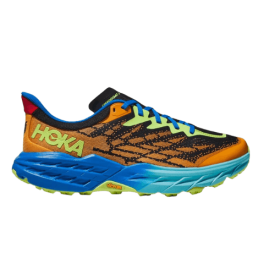
The HOKA Speedgoat 5s feature a tough and grippy Vibram Megagrip outsole that can be suitable for a variety of trail conditions. Additionally, the midsole foam is plush and comfortable, giving you a cozy ride that’s similar to the brand’s on-road offerings.
Specs
- Price: $155
- Weight: 10.3oz
- Heel-to-Toe Drop: 4mm
- Available Colorways: 10
- Available Sizes: 7-15
Pros
- Vibram Megarip outsole provides great traction across multiple terrains
- Mesh upper is comfortable yet durable enough for trails
- Protective toe rand for extra security across the forefoot
Cons
- Midsole cushioning may be too plush for more technical trails
- Not as water-resistant as other trail shoes
- Style may not be best for daily wear
It’s fitting that the best shoe for trail runners has ‘GOAT’ in the product name. The 5th iteration of this classic HOKA silhouette (formerly known as HOKA One One) has all the trimmings of a proper outdoor-ready sneaker. The Vibram outsole is plenty grippy for the uneven terrain you’d experience on a run, and the double-layered jacquard engineered mesh has a good mix of durability and breathability.
I’ve logged plenty of miles in my Speedgoat 5s and routinely turn to them when tackling new trails and routes. I’m confident in each step thanks to the Vibram Megagrip outsole, which features a solid lug pattern that can carry me through multiple scenarios. I rated the outsole design at 5 out of 5.
While there’s a good bit to love underfoot with these trail runners — I also scored the midsole at 4 out of 5 thanks to its comfortable ride through each step — the upper is a pleasant treat. The engineered jacquard mesh upper is durable enough for moderate trails, yet remains breathable enough that you won’t completely sweat through your running socks. Plus, there are neutral and vibrant colorways alike across the roster, allowing you to find the right hue to match your personality when on the trail.
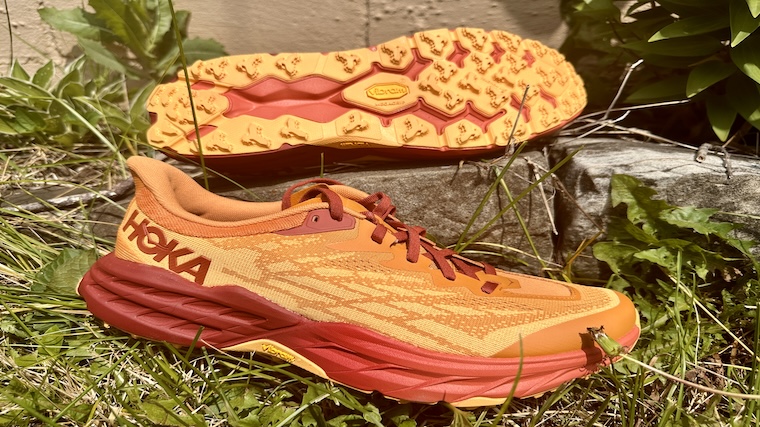
In terms of fit, I rated the Speedgoat 5s at 4.5 out of 5. I’ve never had an issue with rubbing or hot spots, but the toe box does have a slight taper to it that can potentially irritate those with larger feet. Thankfully, though, HOKA does offer these trail-ready kicks in wide sizing.
Of course, these shoes do have their limits in terms of where they can perform best. The midsole, while comfortable, can be too thick at times when trying to focus on your footing over jagged rocks or more technical throughways. In my experience, I prefer to have as much ground feel as possible in these situations. Additionally, if you plan on running in the rain, be sure to purchase the GORE-TEX-lined version — there’s not a lot of water protection across the engineered mesh upper.
Best Road-to-Trail Trail Running Shoes: Nike Pegasus Trail 4 GORE-TEX
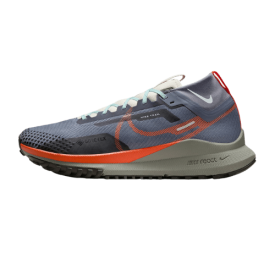
Thanks to its redesigned outsole tread pattern, the Nike Pegasus Trail 4 GTX can be an excellent trail shoe for more packed trailways and road-to-trail scenarios. The partial GORE-TEX lining also helps with water resistance, and the raised ankle collar can be effective for keeping debris out from your shoe’s interior.
Specs
- Price: $160
- Weight: 10.18oz
- Heel-to-Toe Drop: 9.5mm
- Available Colorways: 6
- Available Sizes: 6-15
Pros
- Improved tread pattern is ideal for packed trailways and concrete
- Partial GORE-TEX liner for improved water resistance
- Raised collar helps keep debris out of the shoe
Cons
- GORE-TEX membrane only protects the lower half of the sneaker
- Higher ankle collar may compromise maneuverability for some
- Tread pattern is too shallow for muddier, more technical routes
Not every “trail run” needs to be this exciting off-road excursion — there are plenty of packed trailways that can still warrant a more rugged silhouette than your typical road running shoe. For these milder terrain conditions, we recommend the Nike Pegasus Trail 4 GORE-TEXs thanks to their less aggressive outsole that’s suitable for medium-grade terrain like gravel or wood chips yet still performs well on paved pathways, too.
The Peg Trail 4 GTXs are a regular go-to when I need a pair of shoes for walking through developed trails, or when I know my routes will feature more than one road crossing. The tread is grippy enough for graveled throughways, yet the depth still keeps the noise factor down while pacing overtop asphalt. I’ve even used these as hiking shoes for quick weekend jaunts across beginner-friendly parks and nature preserves with little issues. As such, I rated the outsole at 4 out of 5.
Another reason these can be an ideal pair of shoes for road-to-trail needs is the React foam cushioning across the midsole. Like other Nike running silhouettes, each step has a comfy sense of plush while still retaining some responsiveness when paces call for it. Plus, I scored the cushioning at 4 out of 5 because you can get a decent feel for the ground beneath you on the trail, which can be beneficial when trying to get your bearings over uneven terrain.
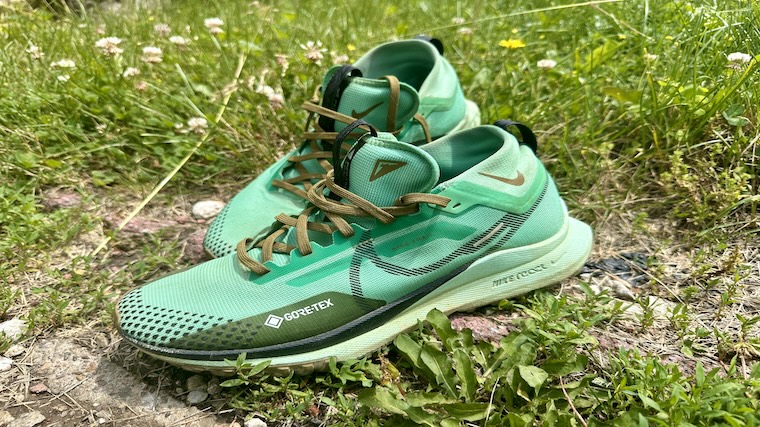
These Nike trail running shoes also feature a partial GORE-TEX membrane, which can be helpful for trekking through shallow puddles along your routes. I say shallow, though, as the membrane does not encompass the entire shoe profile. Any puddle that gets into the raised ankle collar could lead to some sopping socks mid-run. This partial GORE-TEX membrane was also the reason behind my 3.75 out of 5 breathability score — GORE-TEX can keep water in just as easily as it keeps water out of your sneakers.
Best Budget Trail Running Shoes: Merrell Morphlite
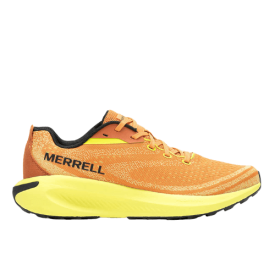
These Morphlites from Merrell can be an excellent option for beginner trail running enthusiasts thanks to their supportive FloatPro midsole and rockered geometry for smooth transitions. Plus, the $100 price tag keeps these kicks affordable, meaning you don’t need to invest a ton into the discipline if you’re just testing the waters.
Specs
- Price: $100
- Weight: 8.46oz
- Heel-to-Toe Drop: 6.5mm
- Available Colorways: 7
- Available Sizes: 7-15
Pros
- Available for roughly $75 less than the average trail running shoe
- FloatPro foam midsole provides a light, comfortable ride
- Cleansport NXT treatment for added odor control
Cons
- Loose upper can lead to some stability issues
- Midsole and outsole can wear down quickly
- Protective overlays are less pronounced than other trail shoes
Given the specialized needs of the discipline, trail running shoes can be more expensive than your typical runner with the average price tag hovering around $175. However, there are some budget-friendly options that can be worthwhile, including the Morphlites from Merrell. At $100, these are well below the median price yet can still provide you with enough traction and comfort for tackling a range of trail conditions.
I’ve been running in these Morphlites for a few weeks now and think they can be an excellent introduction to trail running sneakers. The tread is more pronounced than a road-centric profile, yet not so aggressive that you’ll be sitting high atop the trailway with a disconnected feel for the ground. Plus, I scored the overall ride of these Merrell trail runners at 4 out of 5 thanks to the lightweight feel of the FloatPro cushioning, which pairs nicely to the midsole’s rocker geometry for easy transitions across lighter, more packed routes.
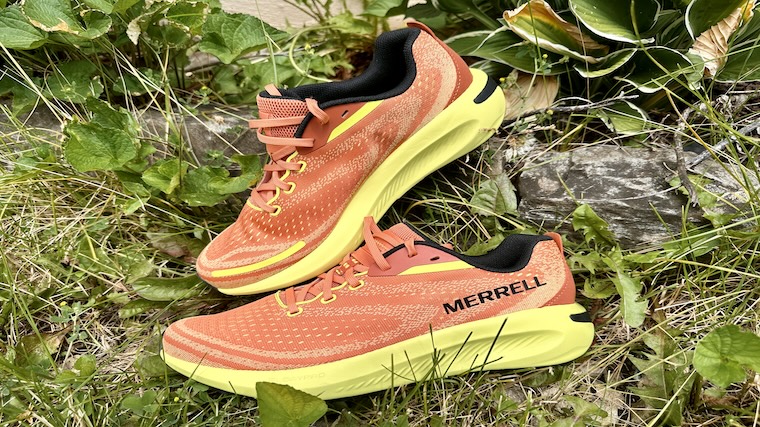
The upper is also comfy enough for regular wear with a good sense of breathability through the engineered mesh. Plus, I like how Merrell treated the shoe with a Cleansport NXT coating, which can help prevent any unwanted odors from developing over time. I’ve had a number of trail running shoes ruined by stench alone (mud and perspiration don’t mix well), so any odor defense is a definite perk, in my opinion.
However, I do wish there was some added structure across this upper design, particularly along the midfoot. I did notice that my feet could move around easily inside the sneaker, which compromised my sense of stability at times. I rated the Morphlites at 3.75 out of 5 for stability, and recommend looking elsewhere if you need the extra support of more dedicated stability running shoes.
The Merrell Morphlites are less protective than other trail runners, too. There isn’t an exterior toe cap or pronounced rock plate, leading to my 3.5 out of 5 rating in the category. However, at $100, you can’t be asking for much more than what’s at play with these beginner-friendly, wallet-friendly kicks.
Best Cushioned Trail Running Shoes: Brooks Caldera 7
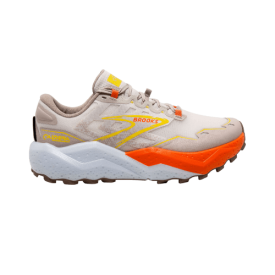
If you’re looking for a well-cushioned ride through the hills and valleys, the Caldera 7s from Brooks can deliver. In addition to this sneaker’s high-stack nitrogen-infused midsole foam, the Caldera 7s also utilize a rugged toe cap that can keep you well-protected from any harsh obstacles or jutting roots along your path.
Specs
- Price: $150
- Weight: 10.6oz
- Heel-to-Toe Drop: 6mm
- Available Colorways: 2
- Available Sizes: 7-15
Pros
- Nitrogen-injected midsole provides a plush ride for longer distances
- TrailTack rubber outsole grips on packed and loose ground
- Rugged toe cap protects against rocks and debris
Cons
- Higher stack height can feel clunky at longer distances
- Fewer available colorways than other trail runners
- Cushioning is less responsive than previous iterations
Sure, trail running can be a fun way to intensify your running workouts … but that doesn’t mean your feet need to be deprived of in-training comfort. Well-cushioned trail shoes can make those longer treks through the backcountry a pleasant treat rather than a grueling endeavor. For our money, the Caldera 7s from Brooks are the perfect vessel for these needs.
In addition to these Caldera 7s, I’ve also logged a heap of miles in this shoe’s predecessor — the Caldera 6 — and do feel Brooks nailed the DNA Loft v3 midsole foam with this iteration. It feels plush and comfy, and you don’t need to put a lot of effort into your steps to achieve that desirable soft landing.
I did rate the cushioning at 4 out of 5, though, due to this sneaker’s lack of responsiveness. The Caldera 6s felt a little bouncier at certain paces with better energy return, which I haven’t experienced in these updated kicks. However, the resolution was quickly found as I fine-tuned my speeds to get the most out of the Caldera 7s.
Of course, with this amount of cushioning, you can expect to clunk up your running gait if you extend your mileage. It takes a while to learn how to use the higher stack height to your advantage on long-distance trails. As such, if I, a mere fitness writer, can do it, you surely can, too.
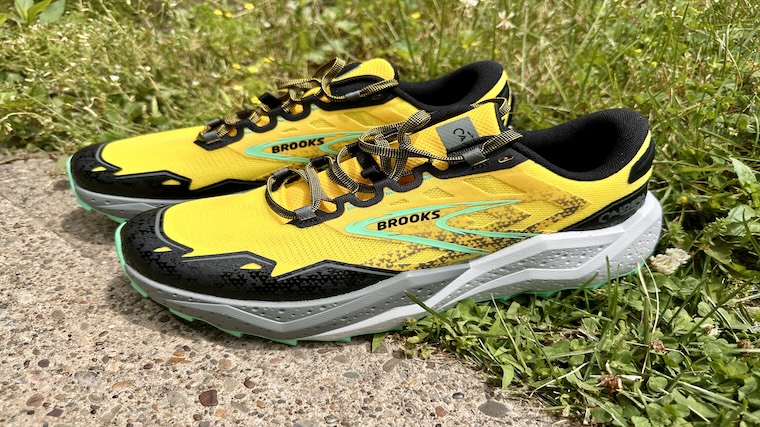
Durability-wise, I rated the Caldera 7s at 4.5 out of 5. I appreciated the more pronounced toe cap that was a great shield against any overgrown roots or jagged rocks during trials. While this does sacrifice some style points (I scored the Caldera 7s at 3.75 out of 5 in that category) I feel it’s worth the price when it comes to real-world use.
Finally, the TrailTack outsole is a nice mix of grip and durability. I’ve taken these shoes through loose and packed terrain with little issues when it comes to underfoot traction. Plus, the lugs seemed to have held up nicely, but only time will tell if that holds true.
Best Trail Running Shoes for Daily Training: Saucony Peregrine 14
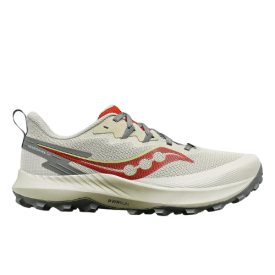
With a PWRTRAC outsole featuring 5-millimeter lugs, the Peregrine 14s can be a grippy, effective trail shoe for those daily miles. The 9.4-ounce weight of this sneaker also opens up the possibility of tempo running — less heft to put the brakes on your speed.
Specs
- Price: $140
- Weight: 9.4oz
- Heel-to-Toe Drop: 4mm
- Available Colorways: 6
- Available Sizes: 7-15
Pros
- PWRRUN midsole creates great cushioning for everyday routes
- Deeper 5-millimeter lugs can be effective on loose terrain
- Added midsole stack height great for road-to-trail conditions
Cons
- Higher stack height can compromise ground feel
- Heel counter sits lower across Achilles than in previous iterations
- Toe box tapers inward, potentially leading to hot spots
Need a trail shoe that can be trusted enough for your daily jaunts? The Saucony Peregrine 14s feature a comfortable PWRRUN midsole that can be plush enough for everyday mileage, while the higher stack height can be excellent for hitting the pavement en route to your wild pathways.
I also like the PWRTRAC outsole design that features deep lugs 5 millimeters. This can help the shoes stay versatile enough for packed and soft terrain, which can be more of an occurrence than you’d think when hitting the trails daily. I scored the outsole at 4 out of 5, because I appreciate this sense of traction, especially when weather is less impactful on my decision to hit the outdoors.
Speaking of versatility, I rated the ride of these Peregrine 14s at 4.5 out of 5. They performed well in shorter, slower workouts, but the lighter 9.4-ounce profile also gave room to open up my paces at times. This can be ideal for athletes looking to improve their average running speed through interval training, although I’d still opt for a lighter road shoe if tempo work is your main goal.
The Peregrine 14s from Saucony also feature a higher midsole stack height than previous iterations. Comparing them to my previous Saucony trail shoes — the Peregrine 13s — I noticed a higher heel (28 millimeters) and forefoot (24 millimeters). This can help create a comfy ride, especially for those brief on-road situations in-between trailheads, but I do feel you lose a bit of ground feel from the thicker slab of foam.
Fit-wise, these Sauconys fit true to size, and are available in wide sizing for larger-footed athletes. I do recommend investigating those options if you routinely max out your shoe interior — the toe box features a slight taper due to the toe cap, which can lead to unwanted rubbing and hot spots.
I also rated the fit at 4.5 out of 5 due to the lower heel counter. While this wasn’t a comfort issue for me per se, I could see how this lower placement could be awkward for some.
Best Trail Running Shoes for Speedwork: HOKA Tecton X 2
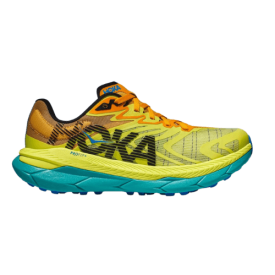
The Tecton X 2s from HOKA are a unique silhouette thanks to the parallel carbon plates sandwiched into the midsole that operate like the suspension system in your car. The plates operate independently from one another, ensuring you get a great energy return and pop in your take-off regardless of how uneven the underfoot terrain is.
Specs
- Price: $225
- Weight: 8.8oz
- Heel-to-Toe Drop: 5mm
- Available Colorways: 6
- Available Sizes: 7-14
Pros
- Parallel carbon plates in midsole for excellent energy return
- New Matryx upper for added durability and water resistance
- Lightweight frame is easy to pick up for faster paces
Cons
- Shorter lugs are less ideal for technical terrain
- Limited colorways compared to other HOKA silhouettes
- Not available in wide or GORE-TEX options
If your pursuits call for a pace beyond the average walking speed, a faster trail running shoe could be just up your alley. The Tecton X 2s from HOKA serve as a rugged workhorse that can also fall in-line with some marathon running shoes thanks to the innovative parallel carbon plates that sit nestled in the midsole for explosive energy return without compromised traction and balance across uneven terrain.
Admittedly, the original Tecton X is what sparked my love affair with trail running. I’m happy to report that this latest iteration only improved on that impactful profile, most notably in the new Matryx upper. I rated this component at 4.5 out of 5 thanks to its hydrophobic qualities that make bursting through shallow puddles and short mud bogs a breeze.
Of course, though, the main reason these HOKA kicks can be excellent for speedwork lies in the midsole design and the parallel carbon plates. Rather than your typical running shoe shank, these plates work sort of like tectonic plates — hence the product name — shifting and adjusting independently to help propel you forward regardless of your underfoot conditions.
I love the zip these shoes provide to my paces and have routinely set trail PRs in them, which I credit highly to the innovative design. As such, I rated the energy return and midsole at 5 out of 5.
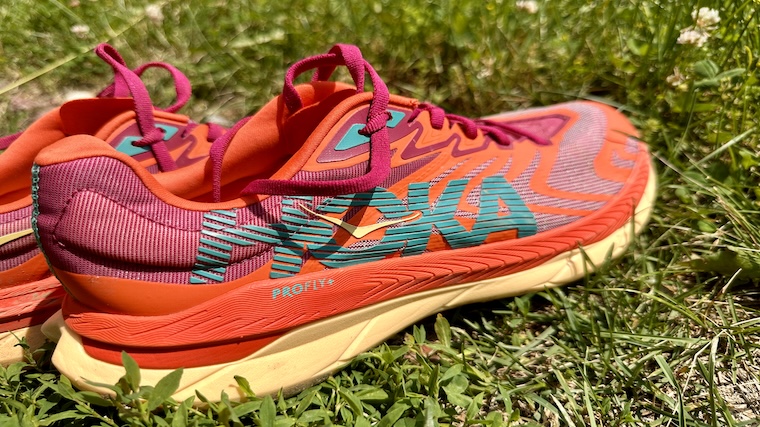
Like other popular HOKA trail running shoes (looking at you, Speedgoats), the Tecton X 2s employ a Vibram Megagrip outsole for excellent traction across a slew of conditions. However, the shorter tread depth of 4 millimeters does limit the grip you can experience on more technical terrain. I’d recommend shifting down a few gears before traversing wet rocks or thick mud, and score the traction at 4 out of 5.
Finally, the fit of these Tecton X 2s is true to size, and I do appreciate the roomy toe box that easily accommodates toe splays for intense push-offs. However, these sneakers aren’t available in wide sizing options (or GORE-TEX, for that matter) so larger-footed athletes may need to size up.
Best Trail Running Shoes for Muddy Conditions: Inov-8 Mudtalon
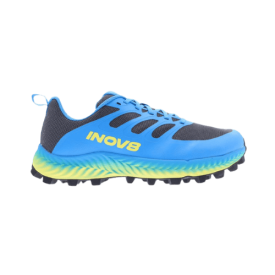
If you’re in need of a mud-ready sneaker to combat the bogs and puddles of your trail route, the Mudtalons from Inov-8 should be your shoe of choice. The long 8-millimeter lugs placed optimally across the STICKYGRIP rubber outsole help ensure traction across the looser environments, leading to less slipping and sliding and more forward progress from trailhead to trail’s end.
Specs
- Price: $140
- Weight: 9.35oz
- Heel-to-Toe Drop: 8mm
- Available Colorways: 2
- Available Sizes: 7-15
Pros
- Longer 8-millimeter lugs for improved traction through softer terrain
- Anatomical last for a more contoured, snug fit
- Added ROCK-PLATE underfoot helps protect against jagged rocks and debris
Cons
- Minimal cushioning can be less ideal for everyday training
- Can run small — we recommend sizing ½-size up
- Stiff heel counter can cause blisters for some
Mud isn’t just a quirky obstacle you’ll encounter at your local obstacle course race — it can be a serious factor to consider when running through the wilderness. For athletes that know conditions are, shall we say, dirtier than others, we recommend the aptly-named Mudtalons from Inov-8 thanks to their 8-millimeter aggressive lugs that can grab hold of any terrain you throw at them.
I’ve run in these rugged kicks before and truly feel they are the mud tires of the footwear realm. I’ve traversed washed-out trails and swampy valleys with zero underfoot issues, which I credit to the deeper lug pattern across the STICKYGRIP rubber outsole. For these reasons, I rated the outsole traction at 5 out of 5.
[Related: 7 Reasons Strength Athletes Should Try Obstacle Course Racing]
The Mudtalons also feature a locked-in, contoured fit, which can be helpful when trying to navigate through loose terrain. You’ll already be thinking about sliding and sloshing across the ground, so there’s no need to add to the sensation with a sloppy fitment.
However, I rated the overall fit and comfort at 3.75 out of 5 because the snug sizing may be too much for some footprints. Do not expect a wide toe box with these trail shoes, and I’ve found that the foot shape last, while secure, does leave room for hot spots and blisters as you learn to run with these aggressive sneakers. Additionally, it may be wise to size up one half size for an optimal fit, or even peruse the brand’s wide-sizing options.
Despite the fitment issues, I still feel these can serve a purpose within your running shoe rotation, even if you rarely encounter mud-filled routes. The ROCK-PLATE shank across the midfoot does provide excellent security and protection against jagged boulders or sharp roots, so you can pace along your trailways with little concern over the safety of your toes and soles.
I rated the security at 4 out of 5, too, given the thicker upper material and protective overlays that can do wonders for preventing any scuffs, scrapes, or piercings during training.
Best Stability Trail Running Shoes: Brooks Cascadia 17
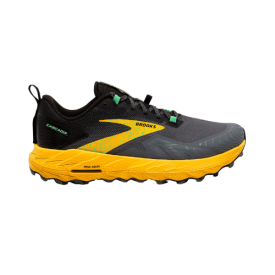
Trail running has you traversing over varied terrain with each twist and turn, so having a stable underfoot sensation is practically required. The Brooks Cascadia 17s utilize a Trail Adapt System, which employs multiple components including soft cushioning, outsole pods, and an integrated plate to help ensure each step feels natural and unhindered.
Specs
- Price: $140
- Weight: 11oz
- Heel-to-Toe Drop: 8mm
- Available Colorways: 6
- Available Sizes: 7-15
Pros
- Trail Adapt System creates a balanced, stable ride
- Sturdy TPU toe cap helps keep your feet protected
- Knit lacing allows for a comfortable yet secure lockdown
Cons
- Can run hot in warm conditions
- Heavier than other trail shoes on the market
- Dense construction makes for a less lively ride
Trail running can be a nightmare for athletes with stability issues since the terrain is so uneven. Thankfully, though, there are some trail shoes that cater to these needs, like the Cascadia 17s from Brooks. These sneakers feature a unique Trail Adapt System across the midsole and outsole to help create balanced landings in each stride for better confidence (and comfort) on the trail.
I’ve been trialing these updated shoes in tandem with their predecessors — the Brooks Cascadia 16 profile — and feel the brand has really taken a step forward in terms of in-training stability. I like the segmented outsole that can easily adapt to uneven terrain, and the protective shank across the middle gives the shoe some structure without feeling too rigid. Plus, DNA Loft v2 foam across the midsole is excellent for keeping steps cozy through the wilderness. I rated the stability at 4.5 out of 5.
The Cascadia 17s are also simple to lock down thanks to the lacing system and flexible upper. The shoes run true to size, so there’s not a ton of play already, but the laces cinch down easily to help secure your foot for traversing rugged trailways. The upper is also well built — I’ve yet to notice a scrape or scuff — and features a sturdy TPU toe cap that runs the entire sidewall of the forefoot for added protection.
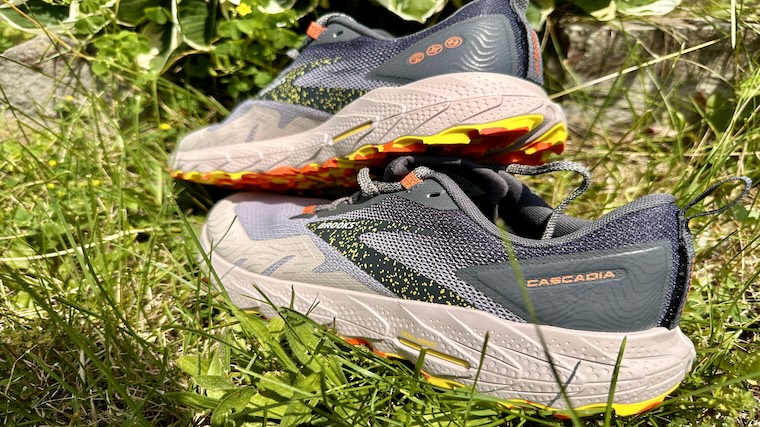
While I rated the protection offered in the Cascadia 17s at 4 out of 5, these levels of defense do compromise the breathability of the shoe. I rated the upper’s breathability at 3.75 out of 5 as they can begin to run hot when taking on a workout in warmer conditions.
The Brooks Cascadia 17s weigh in at 11 ounces, which is on the heavier side of trail shoes. Combine that notion with the fact that these shoes lack a certain responsiveness, and you can quickly confirm that these are not for tempo runs. For cruising through throughways with a heightened confidence and stability, though, they can be a fine sneaker.
Best Trail Running Shoes for Long Distances: Topo Athletic Ultraventure 3

With their anatomical design for a more natural fit and snappy yet comfortable ZipFoam midsole foam, the Ultraventure 3s from Topo Athletic can be a suitable trail shoe for a wide range of needs. A Vibram XS Trek EVO tread pattern also keeps these kicks grippy enough for moderate terrain, although mud and muck may be too much for the 5-millimeter lugs.
Specs
- Price: $150
- Weight: 10.2oz
- Heel-to-Toe Drop: 5mm
- Available Colorways: 4
- Available Sizes: 7-15
Pros
- ZipFoam midsole is comfortable without sacrificing responsiveness during long runs
- Anatomical design can help limit rubbing and blister build-up
- Vibram outsole provides grip and flexibility underfoot
Cons
- Roomier toe box can be to spacious for narrow feet
- Curved heel collar can rub or pinch the Achilles
- Less aggressive tread pattern than other trail shoes
For those longer jaunts through the trees and hills, you want a trail running shoe that can maintain a comfortable underfoot without clunking up your running gait once mileage enters double digits. Utilizing a ZipFoam midsole that delivers comfort, support, and even some responsiveness, the Topo Athletic Ultraventure 3s can be a nice addition to your running ensemble.
In testing, my strides felt natural in this shoe, and I appreciated everything the midsole design brought to the table. The stack height of 35 millimeters at the heel and 30 millimeters at the forefoot provided enough protection without compromising my sense of ground feel. Plus, I scored the cushioning at 4.5 out of 5 thanks to its soft cradling in each landing with enough energy return to keep me moving forward toward the trail’s end.
The upper of the Ultraventure 3s is also worthwhile, providing solid breathability to help prevent unwanted perspiration. The anatomical design, too, can be a blessing for your feet, as there’s no pinching or rubbing along the midfoot and toe box meaning there’s less of a chance of blisters.
However, I rated the fit at 4 out of 5 due to the curved heel counter. On occasions, I could feel this component digging into my Achilles, particularly on hill climbs.
In terms of traction, I’m a sucker for a Vibram outsole. The Ultraventure 3’s Vibram XS Trek EVO tread pattern showcased good durability and flex during trials, and I liked how these shoes felt natural when traversing different obstacles, graveled turns, and more. That said, though, I wouldn’t recommend these kicks for technical or advanced routes as the 5-millimeter lugs aren’t grippy enough for loose rocks or mud. Overall, I rated the traction at 3.75 out of 5.
Despite this outsole callout, I still think the Ultraventure 3s can be worthwhile for those that routinely enjoy maxing out their fitness tracker’s distance data. The ride is natural, there’s enough cushioning underfoot, and (provided you stay on regular terrain) you can get to wherever you’re going at a decent pace.
Best Trail Running Shoes for Winter Conditions: Icebug NewRun BUGrip GTX
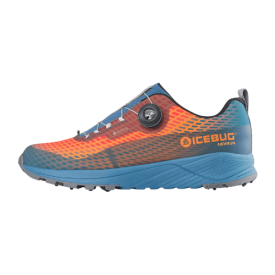
Looking to hit the trails in the middle of winter? The NewRun BUGrip GTXs from Icebug feature a GORE-TEX membrane for improved weather resistance as well as an outsole with dynamic steel studs which can help you maintain your balance and running form even when pacing over ice-riddled trailways.
Specs
- Price: $229.95
- Weight: 11.64oz
- Heel-to-Toe Drop: 7mm
- Available Colorways: 2
- Available Sizes: 7-13
Pros
- BUGrip outsole features steel studs for traction over ice
- Polyester upper and GORE-TEX membrane improve water resistance
- BOA Fit system for quicklace convenience
Cons
- Steel studs can be loud at times
- Wider fit may deter narrow-footed athletes
- GORE-TEX membrane limits breathability, making for a hot interior
If you think about it, running every day implies you’re running year-round. Try as we might, though, winter trail conditions can seriously stall your training streak if you’re ill-equipped with the wrong footwear. The NewRun BUGrip GTXs from Icebug feature a durable, studded outsole for better traction on ice, as well as a polyester and GORE-TEX-lined upper that can help put the freeze on any invading water or precipitation.
Admittedly, I’ve reserved these wintertime runners for packed trails and some road-to-trail throughways, and I don’t feel the outsole pattern is deep enough to take on snow-filled technical terrain. However, I rated the outsole at 4.5 out of 5 thanks to the dynamic steel studs that can help you stay balanced and confident in your strides, especially when pacing across ice. Yes, the steel studs can be loud over asphalt, but I’m willing to deal with the noise for the sake of better footing.
Moving up the shoe, these Icebug profiles feature a rigid polyester upper and GORE-TEX membrane. This can help you stay dry and protected from the elements during outdoor workouts — a definite must when running in lower temps. Of course, though, the inclusion of a water-resistant membrane does compromise the shoe’s breathability, so I scored the upper at 4 out of 5. In my experience, the added warmth is actually a plus in winter, but be smart and don’t sweat out your sneakers if you don’t have to.
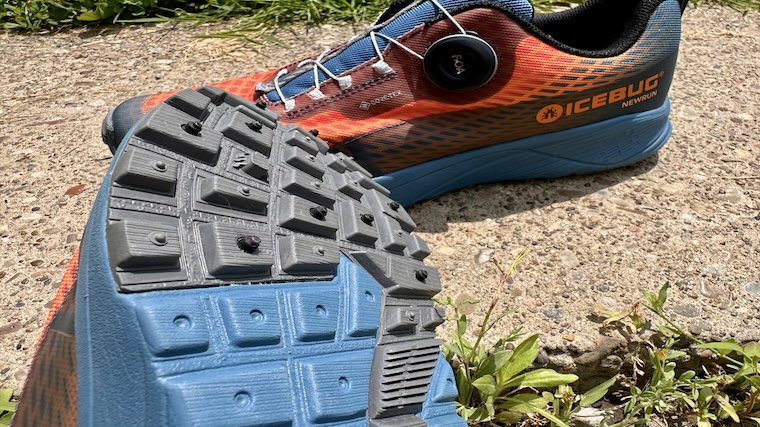
I also like the BOA Fit lacing system across the midfoot that can be ideal when trying to achieve a lockdown with your running gloves and layers on. Rather than your typical bunny knot, the quicklace system operates via turnstile toggle that tightens or loosens thin cords across your shoe.
You can really dial in your fit, which may be necessary more often than not. I rated the Icebugs at 3.5 out of 5 for fit since the design is wider than other sneakers and there’s less flexibility across the upper. Oh well, if you’re trail running in winter, a thicker sock isn’t the craziest idea.
Best Trail Running Shoes for Rocky Conditions: La Sportiva Bushido III
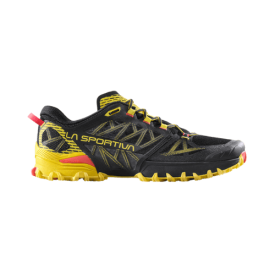
The third iteration of this iconic La Sportiva trail running shoe features a sticky rubber compound across the center of the outsole, improving grip and control in each step. Plus, the lug pattern extends upward along the edge of the midsole, helping you maintain traction even in off-kilter steps over rocks and obstacles.
Specs
- Price: $145
- Weight: 10.5oz
- Heel-to-Toe Drop: 6mm
- Available Colorways: 3
- Available Sizes: 6-14.5
Pros
- Outsole features a stickier rubber center that improves grip on tough terrain
- Thick toe cap for added protection
- Lugs carry into midsole for better traction in off-camber steps
Cons
- Lugs, while grippy, aren’t deep enough for muddy trails
- Only available in 3 colorways
- Cushioning can dwindle during longer runs
Naturally, trail running is going to involve uneven terrain, but if you’re more of a “cut your own path” type of athlete, odds are that your routes will be less pristine with jutting rocks and large boulders abound. For workouts involving these crags and obstacles, we recommend the La Sportiva Bushido IIIs thanks to their grippy, sticky outsole and pronounced lugs along the midsole for stable traction even when your steps are, say, more off-kilter than your proper running form.
Now, I’ve yet to trial these rock-ready trail shoes, but I have logged plenty of hill climbs in the previous Bushido iteration — the Bushido IIs. From what I can tell, the only true updates are a restyling along the outsole, some added mesh panels for better breathability (a big concern of mine in the Bushido IIs), and available wide sizing.
Regardless, I’ve always appreciated the Bi-Compound FriXion XT 2.0 V-Groove3 outsole of this trail shoe. The lugs are tacky enough that you can easily get over rocky terrain. My one go-to route, for example, treks through the base of an old quarry, and I’ve yet to have any missteps due to traction loss. I’d rate the Bushido III’s traction at 5 out of 5, and the overall outsole design at 4 out of 5 since the 4-millimeter lugs are still somewhat shallow for muddier conditions.
The Bushido IIIs also feature a thick TPU toe cap that can be excellent for keeping your feet secure during runs. If you’re traveling over less-groomed terrain, I always appreciate as much protection as possible.
Cushioning wise, this sneaker uses the same EVA midsole design as its predecessor. I’ve felt supported enough for backcountry excursions, but I wouldn’t necessarily call it a plush experience. I rated the cushioning at 4 out of 5 as you need a little rigidity to create that stable, rock-ready platform. So, as long as you understand the purpose of this sneaker and don’t take it on lengthy runs, you should feel a similar sensation.
Most Durable Trail Running Shoes: Norda 002
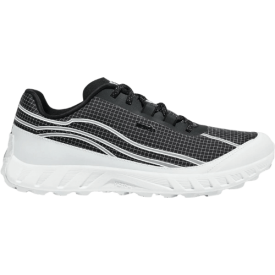
This impressive 002 silhouette from Norda is made with Dyneema, which is one of the strongest fibers on earth. While the price is heavy upfront, these kicks are designed to be a stalwart in your shoe rotation — you don’t need to replace a shoe if it can take the abuse and bounce back day in and day out.
Specs
- Price: $295
- Weight: 7.73oz
- Heel-to-Toe Drop: 4mm
- Available Colorways: 3
- Available Sizes: 8-14
Pros
- Upper is made from Dyneema, one of the world’s strongest fibers (1)
- Vibram Megagrip outsole retains its traction and sense of grip
- Clean aesthetics that can be worn with normal attire
Cons
- One of the most expensive trail running shoes available
- Practically no breathability through the Dyneema upper
- Laces can come undone with lighter knots
If you’re really invested in trail running, it can be beneficial to have a pair of shoes that will last you multiple seasons. While the price may be jarring at first, the Norda 002s showcase exceptional value thanks to their rugged durability. While the Vibram outsole is more sturdy than other rubbers, the real highlight of the profile is the Dyneema upper.
Dyneema is one of the strongest, lightest fibers on the planet and is trusted for ballistic helmets, crane ropes, and parachutes. (1) If it can withstand these stresses, what do you think it can do in the footwear space?
I’ve run in Norda’s other silhouette, the Norda 001, and can attest to the strength of the Dyneema design. I scored the Norda 002’s upper at 4 out of 5, though, given that Dyneema, while durable, is not breathable at all. If you’re training under the hot sun, expect to sweat through your socks.
[Related: What Does It Take To Get Into Trail Running? An Ultrarunner Shares His Secrets]
The laces also contain Dyneema fibers, which can be great for durability and structure across an often forgotten shoe component. However, the strength of the fabric does limit its stretch. I’ve found that the knots can come undone easily, especially if you don’t cinch down the laces tightly.
I also like the Norda 002s simply for the style at play. Unlike other trail shoes that feature vibrant patterns and bright colorways, the 002s are more neutral. This can lend itself to more versatile wear, even with normal attire. I scored the style at 4 out of 5 as I think this is the best example of athletic pursuits meeting the gorpcore style trend (look it up).
Of course, the price cannot be ignored — nearly $300 for a single pair of shoes is pricey for any budget. However, I still scored the value at 4 out of 5 as I feel the Norda 002s can easily last multiple years on the trail. It’s a steep upfront investment, but the kicks can pay for themselves in no time.
Best Trail Running Shoes for Wide Feet: Altra Lone Peak 8
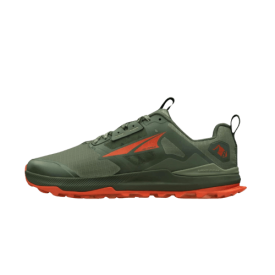
The Lone Peak 8s are Altra’s trail-ready silhouette crafted with many of the brand’s signature components including a minimalist 0-millimeter heel-to-toe drop and anatomical FootShape profile for better fitment. The Lone Peak 8s also feature a more resilient ripstop nylon upper that can be sturdy enough for the wear and tear of trail running while still retaining some breathability along the design.
Specs
- Price: $140
- Weight: 10.7oz
- Heel-to-Toe Drop: 0mm
- Available Colorways: 5
- Available Sizes: 7-16
Pros
- FootShape fit features a roomy toe box
- New ripstop nylon upper for better durability
- EGO midsole foam provides comfort without compromising ground feel
Cons
- MaxTrac outsole can be slippery in wet conditions
- Zero drop, minimalist design is not for everyone
- Midsole foam can compress at the heel, especially during descents
Wider-footed athletes can sometimes struggle to find proper-fitting trail shoes. However, there are some silhouettes that naturally cater to these foot sizes like the Lone Peak 8s from Altra. These trail shoes utilize the brand’s signature FootShape design to create an anatomical footprint that’s roomy across the midfoot and spacious enough in the toe box to eliminate any unwanted rubbing.
I also rated the fit of the Lone Peak 8s at 4.5 out of 5 thanks to the Ghillie-style lacing that allows for a customized lockdown across the top of the foot. You feel locked into the sneaker, but it’s not a constricting fit that could otherwise compromise the comfort level.
The Lone Peak 8s also feature a new ripstop nylon upper, which I scored at 4 out of 5 and feel is a great addition to this Altra profile’s makeup. The previous Lone Peak 7s had a mesh upper that was breathable and cozy yet lacked a certain sense of sturdiness. The new ripstop nylon improves the overall protection while still giving you some ventilation for those extra-hot days on the trail.
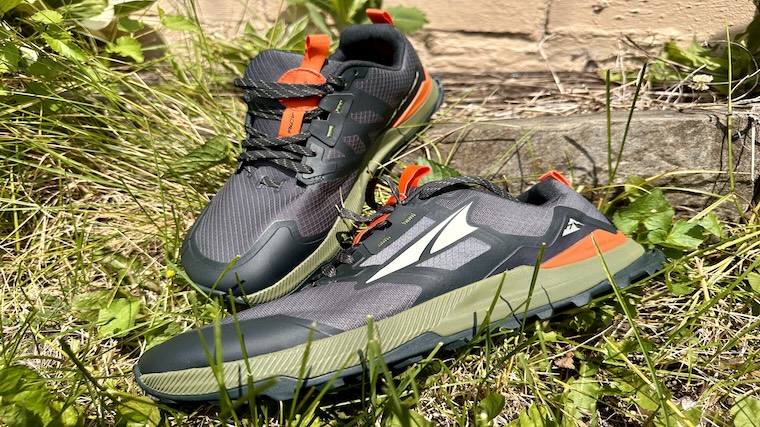
Unfortunately, though, Altra is still using the MaxTrac outsole in this sneaker. In my experience with multiple trail running silhouettes, this is my least favorite outsole pattern. The lugs are too shallow for muddy conditions, and the material itself wears down easily and can lead to slippery steps even when on packed trailways.
I also rated the overall ride at 3.75 out of 5 given this shoe’s zero-drop design. Barefoot running, according to studies (and lore), is designed to help you achieve a more natural running gait and may be more beneficial for your body. (2) However, it takes some foot strength to hop from a higher drop shoe directly into a minimalist silhouette. If you’re curious about these sneakers, I suggest taking your time and getting used to the underfoot sensation — it’s not for every footprint.
Best Customizable Trail Running Shoes: Speedland GS:PGH
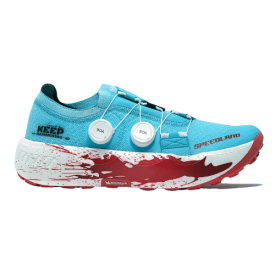
With a unique drop-in midsole that’s compatible with Carbitex GearFlex plates for added energy return, the GS:PGHs from Speedland can be an ideal pick for athletes wanting to mix up their training between comfortable jaunts and speed-focused runs. The dual BOA Li2 dials along the upper also allow for a fine-tuned fit that can be easily loosened or tightened with the simple turn of the toggle.
Specs
- Price: $275
- Weight: 10.5oz
- Heel-to-Toe Drop: 7mm
- Available Colorways: 1
- Available Sizes: 5-14
Pros
- Drop-in midsole pairs with Carbitex GearFlex plates for added responsiveness
- Dual BOA Li2 dials for micro-adjustments across the upper
- Lightweight PerformFit wrap provides security and breathability
Cons
- Shoes often sell out due to limited batches
- More expensive than other trail running shoes
- Weight can begin to alter performance at longer distances
Having the ability to customize your trail running footwear can help create an optimized ride and training experience that caters to your wants and needs. The GS:PGHs from Speedland offer a heightened sense of customization thanks to their dual BOA Li2 lacing system for micro adjustments across the lockdown, as well as a unique drop-in midsole that can pair with compatible carbon fiber plates for more or less energy return.
I’ve had multiple pairs of GS variations over the years and really enjoy the versatility across the drop-in midsole. The component operates like a traditional drop-in insole and I like how easy it is to add the Carbitex GearFlex plates for days where tempo and speed are desired. I rated the midsole at 4.5 out of 5, too, because the cupped sidewalls create a comfortable cradle for your foot for added security.
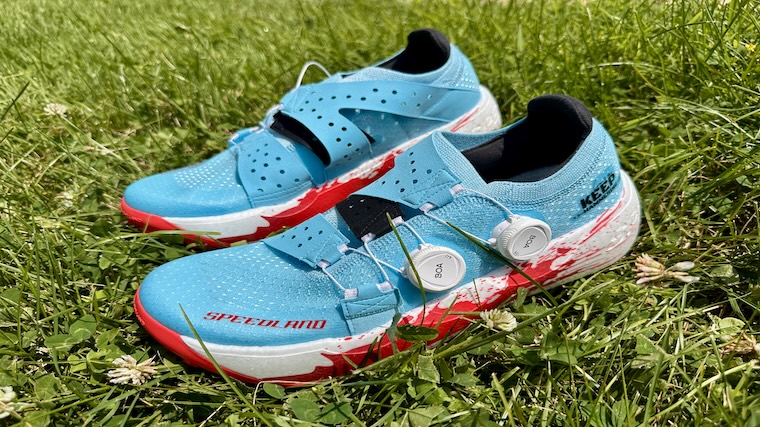
The BOA Li2 toggles also deserve some praise thanks to their quick and intuitive operation. Rather than popping the turnstiles to loosen the attached cables, you can simply turn the dials one way or another to achieve your desired fit. Given this ability to micro adjust your comfort, as well as the anatomical layout of the shoe itself, I rated the fit at 5 out of 5.
[Related: How Many Calories Are Burned Running a Mile?]
As impressive as this shoe is, though, I couldn’t score the value any higher than 3.5 out of 5. The $275 price tag is above the average trail shoe, and the Carbitex GearFlex plates are sold separately meaning an extra purchase is required to unlock the full customizability of the profile. Additionally, the GS lineup is sold in limited batches — don’t be surprised to find your specific size out of stock.
Thankfully, though, if you do find that the GS:PGHs are out of stock, the GS:PDX, GS:OAK, and GS:TAM silhouettes are all virtually the same sneaker with slight differences in weight. You’ll just need to compromise on the colorway.
Benefits of Trail Running Shoes
According to Amanda Capritto, CPT, CES, CNC, CF-L1, CSNC, your footwear can be one of the most important pieces in your fitness regimen, “especially if you follow an exercise protocol that requires versatile shoes.” As such, a proper pair of trail running shoes can vastly improve your experiences through the exciting and adventurous training discipline. Below are some of the perks that can come with adding trail running shoes to your workout arsenal.
- Improved Traction: Trail running shoes feature a more aggressive outsole than road running sneakers, which can be beneficial for maintaining traction along the uneven and loose terrain. Think of it like putting all-terrain tires on your car — the deeper lugs and more aggressive tread pattern can easily grip mud, rocks, and dirt for a better ride.
- Protection from Terrain: Trail running also involves you scaling over obstacles like roots, logs, and boulders which, on occasion, can lead to unwanted impacts that leave you feeling sore across your feet. Shoes designed for trail running feature harder, more durable overlays in key areas like the toe box to help you stay protected as you pace through your outdoor-minded workouts.
- Limits Footwear Overuse: Having a pair of trail running sneakers can also be a benefit for your other running shoes, too. Having footwear for each terrain can help preserve each silhouette’s integrity and prevent overuse while also allowing the midsole foams to fully rebound in-between workouts.
How Much Do Trail Running Shoes Cost?
As with other specialized footwear for ultramarathons, race day, stability, and even shoes for treadmill running, you can expect to pay a little more for trail running shoes than your average pair of loafers. In our years of testing and reviewing footwear, though, we’ve determined that roughly $175 can be a good median price to start with when looking at the category. Read below to compare the prices of trail running shoes featured in this round-up.
| Best Trail Running Shoes Overall | HOKA Speedgoat 5 | $155 |
| Best Road-to-Trail Trail Running Shoes | Nike Pegasus Trail 4 GORE-TEX | $160 |
| Best Budget Trail Running Shoes | Merrell Morphlite | $100 |
| Best Cushioned Trail Running Shoes | Brooks Caldera 7 | $150 |
| Best Trail Running Shoes for Daily Training | Saucony Peregrine 14 | $140 |
| Best Trail Running Shoes for Speedwork | HOKA Tecton X 2 | $225 |
| Best Trail Running Shoes for Muddy Conditions | Inov-8 Mudtalon | $140 |
| Best Stability Trail Running Shoes | Brooks Cascadia 17 | $140 |
| Best Trail Running Shoes for Long Distances | Topo Athletic Ultraventure 3 | $150 |
| Best Trail Running Shoes for Winter Conditions | Icebug NewRun BUGrip GTX | $229.95 |
| Best Trail Running Shoes for Rocky Conditions | La Sportiva Bushido III | $145 |
| Most Durable Trail Running Shoes | Norda 002 | $295 |
| Best Trail Running Shoes for Wide Feet | Altra Lone Peak 8 | $140 |
| Best Customizable Trail Running Shoes | Speedland GS:PGH | $275 |
What to Consider Before Buying Trail Running Shoes
Like any piece of fitness equipment, there are a few factors to consider before deciding on a pair of trail running shoes. From your typical trail conditions to the shoe’s cushioning, fit, price, and more, here are the components we recommend thinking through as you work through the purchasing process.
Terrain Conditions
Naturally, your trail running shoes should feature a more aggressive outsole that’s designed for running on uneven and loose ground. However, it can be beneficial to also consider the specific conditions of your intended trails, as certain tread patterns can cater to different terrains.
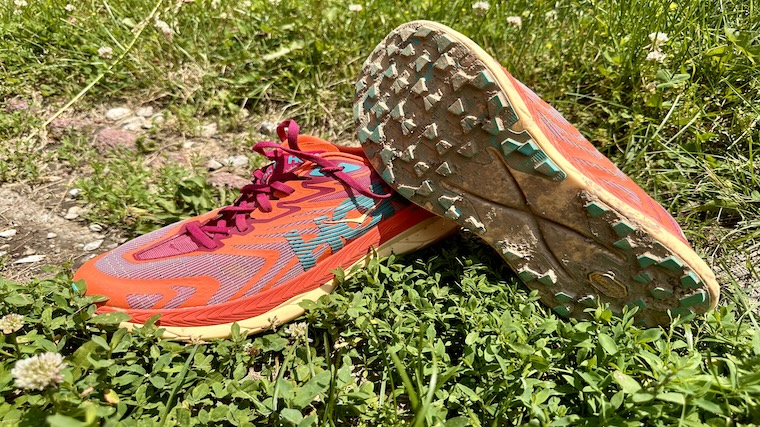
For example, if you know your trail is filled with mud puddles or bogs, it can be wise to opt for a tread featuring deeper lugs to accommodate the wet, mucky conditions. If you routinely train atop packed trailways or paved hiking routes, you may be better off with a less aggressive outsole.
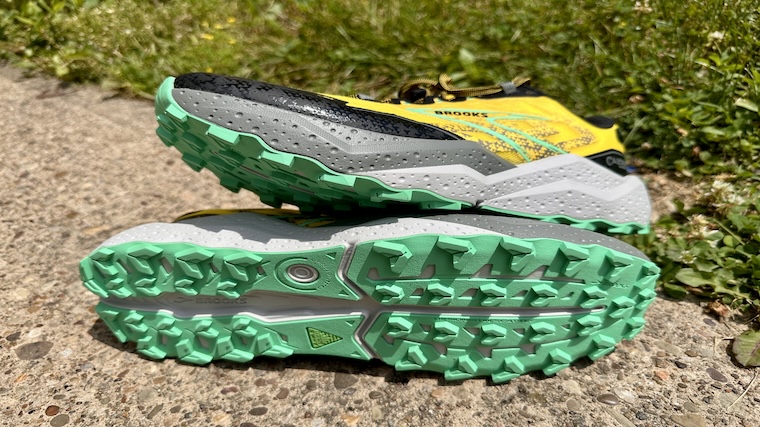
While this awareness may call for a field trip to your trails before purchase, you can also use technology to see what you’re likely up against before getting out into the wild. Some running apps offer descriptions for specific trails, with condition reports and photos to better gauge your terrain.
Cushioning
Finding the right cushioning for trail running is a little different than searching for cushioning in other running shoes. Yes, you want to opt for a comfortable ride that keeps your feet cozy through landings and toe-offs, but you also want to preserve a sense of ground feel that can allow you to adjust your steps in accordance with the terrain.
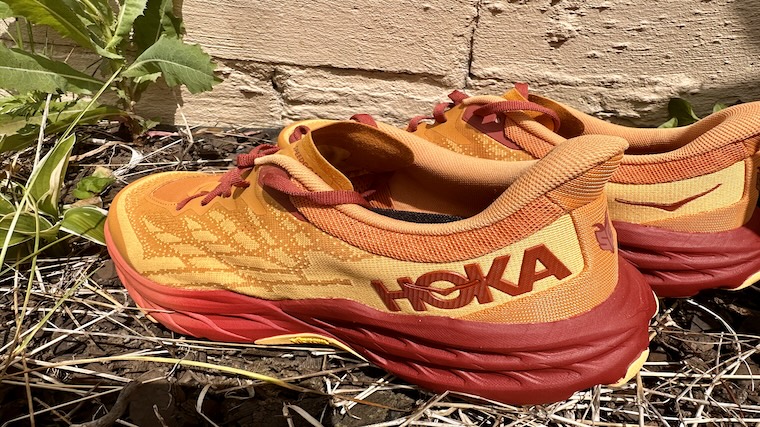
In my experience, a trail shoe that’s too plush can leave you disconnected from the path underfoot, which can result in errant strides over looser ground and unwanted slips and spills. That said, however, there’s no need to feel every pebble you trek over. It’s a give and take, so look for a midsole design that gives you a mix of both comfort and feel that matches your needs best.
Over-Foot Protection
The rough terrain of trail running can put your feet through a lot, so having a protective design can be beneficial when taking on a route filled with obstacles. Typically, it can be wise to opt for a trail shoe with a pronounced toe cap, since this is an area that can be most exposed to impacts with jutting roots and large rocks. Other protective components include midsole rock plates, side wall shields, and higher ankle collars to help keep pebbles and debris from getting inside your shoe.
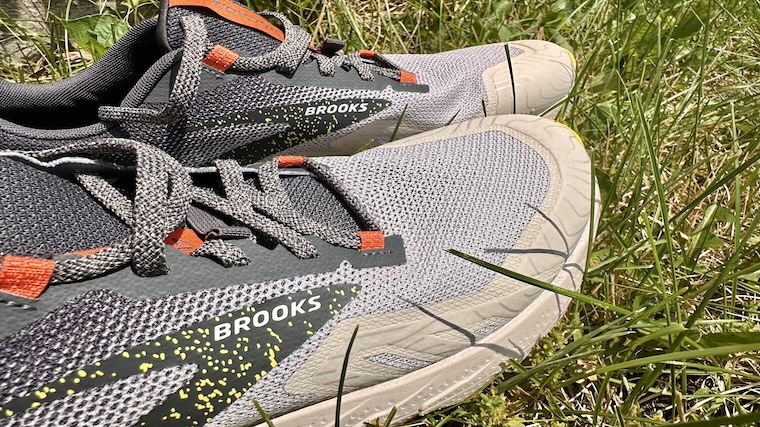
If you’re tackling more groomed trailways, you can likely get away with just a stable toe cap and a resilient upper. For more advanced paths, though, I recommend erring on the side of caution. Be mindful, though, that extra overlays can compromise your shoe’s breathability, so be prepared to sweat if your profile is decked out with multiple defense mechanisms.
[Related: Running on a Treadmill Vs. Running Outside — Which Is Best for Your Goals?]
Fit
Of course, your trail shoes should accordingly. Be sure to look for profiles offered in your foot size and look at the brand’s specific size guide to see if you need to size up or down for an ideal fitment. For larger-footed athletes, it can be wise to look for trail running shoes offered in wide sizing, too.
Price
On average, trail running shoes cost roughly $175, although you can find many top-performing silhouettes for prices between $140 and $150. The median price tag is skewed higher given that some trail shoes can cost upwards of $300 due to their durable fabrics, carbon-plated midsoles, and convenient lacing systems.
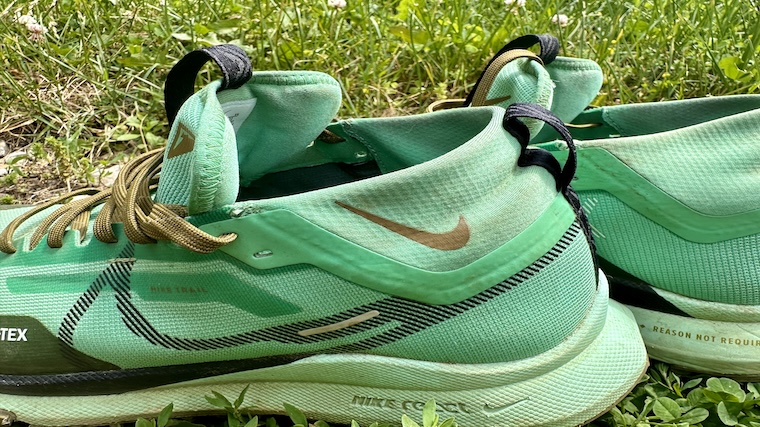
In the end, though, the best trail running shoe for your training preferences is the one that fits your budget best. Crunch some numbers and determine how much you’re willing to spend on a pair of outdoor-ready kicks and begin your search there.
Best Trail Running Shoes FAQs
What are the best trail running shoes?
Classifying the best trail running shoes can be subjective from athlete to athlete. In our opinion, though, the HOKA Speedgoat 5s are the top-performing trail runners thanks to their comfortable and breathable engineered jacquard mesh upper, cozy midsole, and durable Vibram Megragrip outsole that can easily provide traction across a variety of terrain conditions.
Can you use trail running shoes for regular running?
In theory, yes, but it comes down to using the right tools for the trade. The tread pattern featured across trail running shoes is designed for looser terrain, whereas the flatter outsole of a road running sneaker is optimized for flat asphalt and treadmill belts. The differences in running experience can be minimal, but you can likely expect more audio feedback and compromised traction, similar to what you’d experience when putting all-terrain tires on your vehicle versus street tires.
How much do trail running shoes cost?
While a majority of trail running shoes can be found between $140 and $150, the average cost of trail running shoes sits at roughly $175. This is due to some silhouettes costing upwards of nearly $300, thus skewing the median price tag.
Are trail running shoes uncomfortable?
Whether a shoe is uncomfortable or not can be subjective. However, trail running shoes are intended to provide traction and protection against uneven terrain and varying obstacles, which limits their breathability and flexibility when compared to more plush road running profiles. There are plenty of cozy trail shoes available, though, so don’t feel as if comfort is always compromised within the category.
References
- Sanborn, B., DiLeonardi, A. M., & Weerasooriya, T. (2014, December 24). Tensile properties of Dyneema SK76 single fibers at multiple loading rates using a direct gripping method – journal of dynamic behavior of materials. SpringerLink. https://link.springer.com/article/10.1007/s40870-014-0001-3
- Cleveland Clinic. (2024, April 30). The benefits of barefoot running. https://health.clevelandclinic.org/barefoot-running